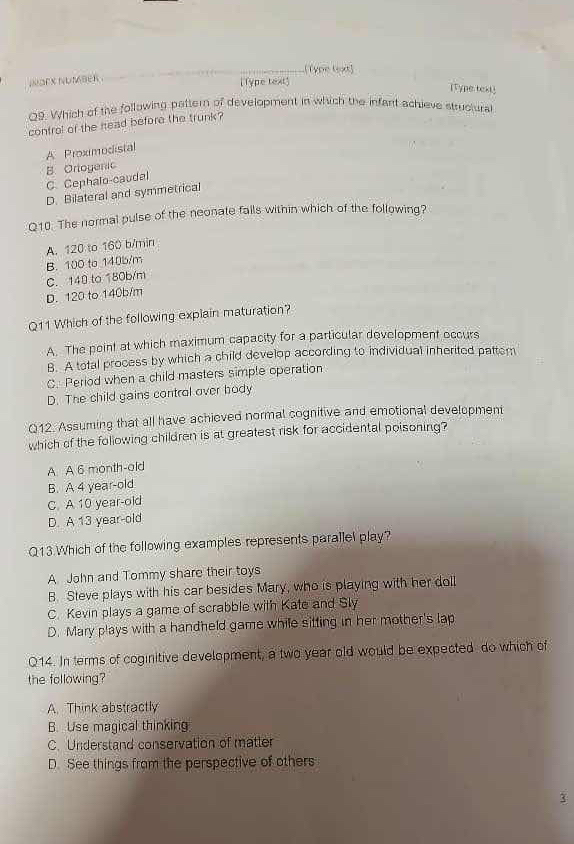Which of the following patterns of development in which the infant achieves structural control of the head before the trunk? The normal pulse of the neonate falls within which of t... Which of the following patterns of development in which the infant achieves structural control of the head before the trunk? The normal pulse of the neonate falls within which of the following? Which of the following explain maturation? Assuming that all have achieved normal cognitive and emotional development which of the following children is at greatest risk for accidental poisoning? Which of the following examples represents parallel play? In terms of cognitive development, a two year old would be expected to do which of the following?

Understand the Problem
The questions are related to child development, covering topics such as patterns of development, physiological norms, maturation, cognitive development, and play types.
Answer
Q9: Cephalocaudal, Q10: 120 to 160 b/min, Q11: A total process by which a child develops according to individual inherited patterns, Q12: A 2-year-old, Q13: Steve plays with his car besides Mary, who is playing with her doll, Q14: Use magical thinking.
The answers are: Q9: Cephalocaudal, Q10: 120 to 160 b/min, Q11: A total process by which a child develops according to individual inherited patterns, Q12: A 2-year-old, Q13: Steve plays with his car besides Mary, who is playing with her doll, Q14: Use magical thinking.
Answer for screen readers
The answers are: Q9: Cephalocaudal, Q10: 120 to 160 b/min, Q11: A total process by which a child develops according to individual inherited patterns, Q12: A 2-year-old, Q13: Steve plays with his car besides Mary, who is playing with her doll, Q14: Use magical thinking.
More Information
Cephalocaudal development involves gaining control from head down to tail, impacting infant milestones. A newborn's normal pulse is usually higher than adults. Maturation is influenced by genetics. Development stages vary risk of accidents. Parallel play involves playing alongside others without interaction. Two-year-olds typically engage in symbolic or magical thinking.
Tips
Confusing cephalocaudal with proximodistal development is common; focus on head-to-tail vs. center-to-limb growth patterns.
Sources
- Problem 1 Which of the following principle... [FREE SOLUTION] - Vaia - vaia.com
- Development Milestones - StatPearls - NCBI Bookshelf - ncbi.nlm.nih.gov
AI-generated content may contain errors. Please verify critical information